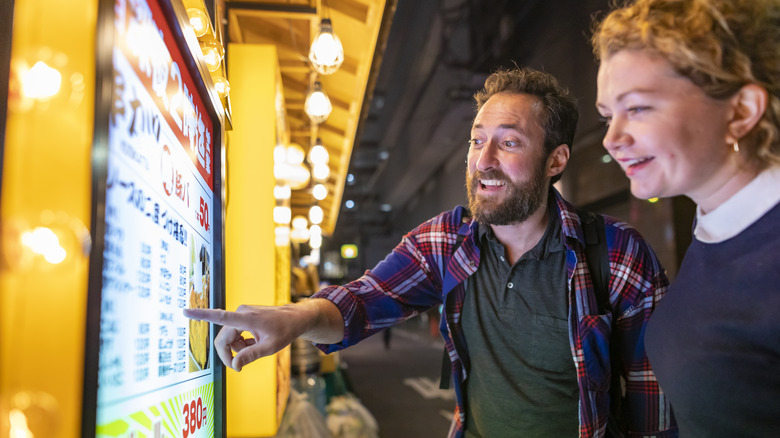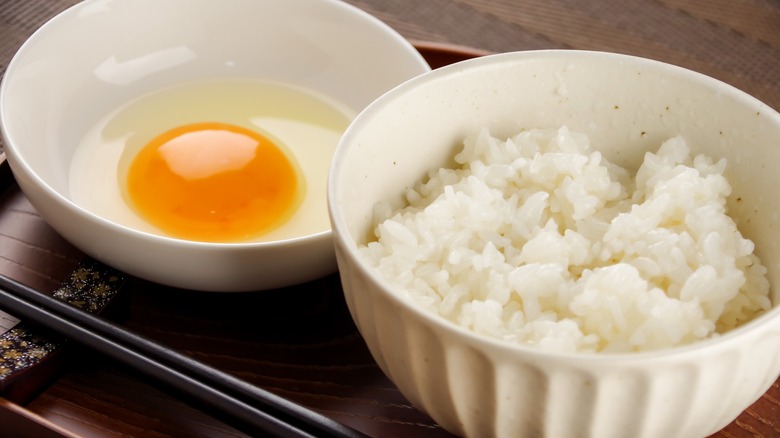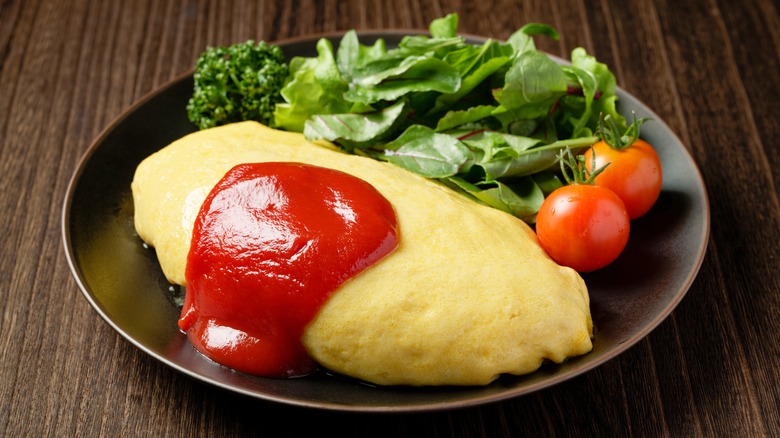The Potentially Dangerous Food In The US Tourists Should Expect To See On Menus In Japan
When you visit Japan, don't be alarmed to see entrees topped with raw egg on certain restaurant menus. It's not uncommon there, though it may go against everything you've ever learned about the dangers of salmonella. From the farm to the factory, Japanese eggs are held to a different hygienic standard than those in the U.S., where there are around 1.35 million salmonella infections per year, according to the Centers for Disease Control and Prevention.
Japan's Ministry of Agriculture, Forestry, and Fisheries lays the groundwork with a list of comprehensive guidelines (pdf) for anti-salmonella measures. Chickens are vaccinated against the bacteria, while their eggs undergo thorough sanitization and inspection via high-tech processing equipment. This includes sterilizing the eggs with ozonated water and UV light and checking them for blood spots and tiny, imperceptible cracks.
As a result, Japan only sees about 3,000 salmonella cases a year — roughly 0.002% of the number recorded stateside. Yet the country is second only to Mexico in egg consumption worldwide, per the International Egg Commission (via The Mainichi). People in Japan ate an average of 339 eggs — almost one a day — in 2022. At least some of those were raw eggs, served with dishes like sukiyaki, where the freshly beaten egg serves as a dip for boiled vegetables and beef or pork. Though you might experience a bit of culinary culture shock, and the gooey texture won't suit everyone's taste buds, you can sample raw egg as the locals do and know that it's generally safe to eat.
Test your culinary boundaries with these raw egg dishes in Japan
Like fugu, raw egg is a food tourists are better off ordering in Japan, if they're brave enough. Just remember the movie "Rocky," in which Sylvester Stallone's boxer-in-training cracks open three raw eggs in a glass and then drinks them down straight, chugging pure protein. Japan's consumption of raw eggs is actually more modest, though people have been known to drink them with sake as a home remedy for colds. In the case of sukiyaki, a hot pot dish available at shabu-shabu restaurants like Shabuzen, you're likely to see one raw egg served per person. Popular gyudon (beef bowl) chains, such as Yoshinoya and Sukiya, offer a single raw egg as one of their standard toppings, which you can order on the side or in a value set.
One breakfast dish where raw egg is a key ingredient is tamago kake gohan, or TKG, where you mix the egg in with soy sauce over rice. In Tokyo, you can get TKG at restaurants like Tamago no Ohanashi and Kisaburo Farm, the latter of which has an all-you-can-eat lunch set with unlimited raw eggs for anyone on the Rocky diet. Some travelers, of course, may be as hesitant to try raw egg as they would be eating natto, the fermented soybean dish that's infamous for being sticky and smelly (though it's also considered a healthy superfood). For a traditional Japanese breakfast that's something of double dare, you could try combining TKG with natto.
Alternatives for those who prefer cooked eggs
In a country where raw fish is a way of life, uncooked egg is arguably no more exotic than sushi or sashimi. In fact, you might have a greater risk of getting sick from the latter, since the fish-borne parasite anisakis has caused more food poisoning in Japan than salmonella (via The Mainichi). Still, anyone who finds raw eggs unappetizing can look to other egg-topped Japanese dishes as alternatives. Even sushi fits the bill when you order tamagoyaki (rolled omelet) nigiri.
Another example is omurice, where an omelet is folded over rice and drizzled in ketchup or demi-glace sauce. The Osaka restaurant Hokkyokusei bills itself as omurice's birthplace, though you can also order it in hotels and chains like Ducky Duck. In Hiroshima, where the Okonomimura theme park is a must-visit for foodies, a fried egg usually tops off okonomiyaki (savory Japanese pancakes). Soft-boiled eggs are a ramen staple, while Tokyo yakitori shops like the Michelin-starred Yakitori Omino sometimes save oyakodon (chicken and egg over rice) for the last course.
Just as Japan's 7-Elevens are a coffee paradise, you can also walk in the store occasionally and see an entire refrigerated shelf of sandwiches, all with egg in them. Travel host Anthony Bourdain — who wasn't averse to eating things raw — preferred the egg salad sandwiches at rival convenience store Lawson. As long as you're not worried about cholesterol, you can find raw and cooked eggs all over the menu in Japan, for breakfast, lunch, and dinner.


